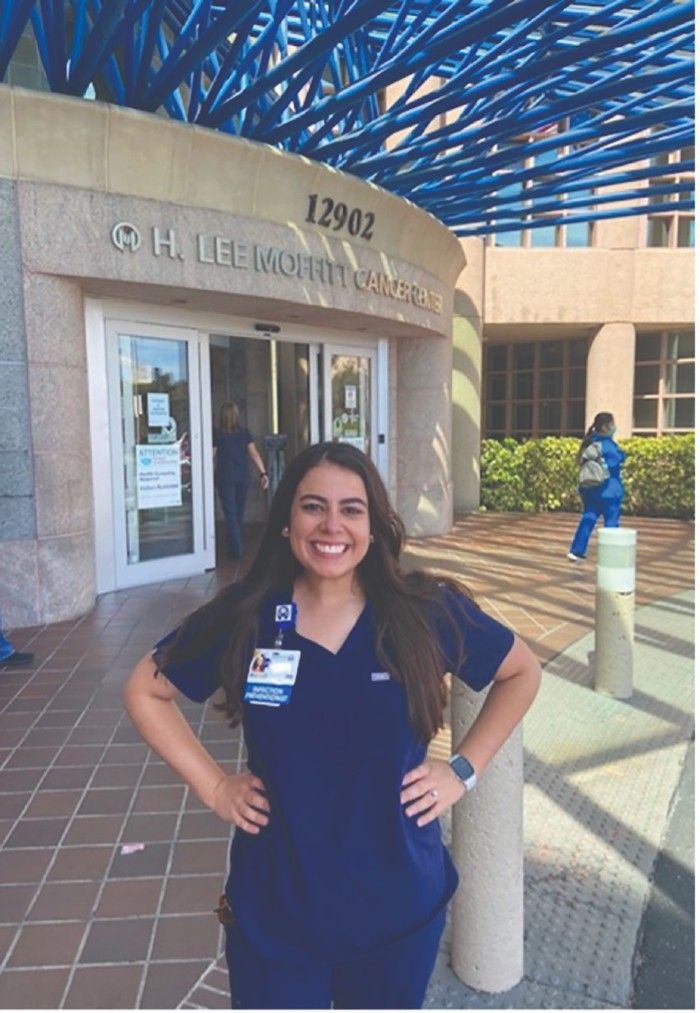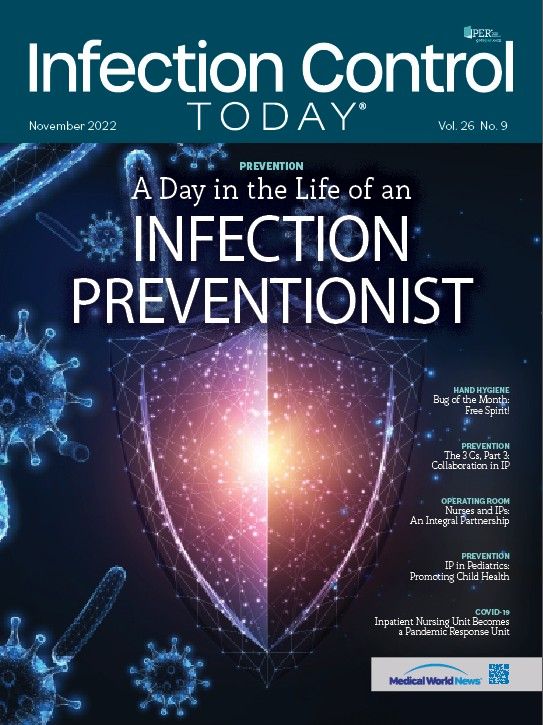A Day in the Life of an Infection Preventionist
What exactly does an infection preventionist (IP) do all day? One IP gives ICT’s readers an inside look.
Infection Preventionists are warriors. Read on to see what they do on an average day.

The US Centers for Disease Control and Prevention (CDC) estimates that roughly 1 in 25 hospital patients in the United States will receive a diagnosis of a health care-associated infection (HAI) every year.1 Infection preventionists (IPs) are actively engaged in and tasked with managing their health care facility’s infection control plan (ICP) to minimize the risk of HAIs for patients, staff, and visitors.
The role of an IP is all-encompassing. As pathogens can lurk in any and every nook and cranny of a health care facility, the highly versatile IP engages with all departments of a health care facility to prevent transmission. Although each day can present unexpected challenges of its own, at the core of an IP’s day are key components such as surveillance, mitigation, education, and data analysis and dissemination. The following account of an IP’s day includes a snapshot of what a typical day can be—that is, if all goes according to schedule.
The author in front of the facility where she works as an infection preventionist. (Credit: Author)

Currently, I am an IP at a 206-bed National Cancer Institute–designated comprehensive cancer center in Florida. Typically, my day starts at 8:30 AM and ends at 5:00 PM.
8:30 AM: After completing my COVID-19 screening at the door when I arrive, I head to the Infection Prevention and Control (IPC) office. I first browse through my email. There is an assortment of messages ranging from requests from providers to remove patients off isolation to new infection control risk assessments (ICRAs) awaiting an IP’s signature to approve upcoming construction projects throughout the hospital.
9:00 AM: It is time to review all the positive results the IPs received the previous day. These include the hospital’s reportable infections, respiratory viruses, vancomycin-resistant Enterococcus, methicillin-
resistant Staphylococcus aureus, and others. At this time, I will also enter the patient’s electronic medical record and ensure they have the proper isolation ordered if needed. I call inpatient floors and ensure the patient has the appropriate isolation sign on their door and that floor staff are cognizant of the results. I determine whether these positive results are hospital acquired or community acquired. This is a critical component of surveillance, and the determination is based on how long after admission the patient tested positive. I ensure that the patient was not previously positive or had already displayed signs and symptoms at the time of admission. I review any new positive blood and urine cultures that have resulted and send the appropriate workup to the CDC’s National Healthcare Safety Network if one of these cultures is determined to be a CLABSI (central line-associated bloodstream infection) or CAUTI (catheter-associated urinary tract infection).
10:00 AM: Time for rounds. I complete rounds on all my assigned units and clinics in the cancer center, ensuring the staff are following infection control practices and are survey ready. Survey readiness is ensuring your facility is prepared at any time for an unannounced visit from The Joint Commission; this means proactively maintaining a safe and high-quality environment. Areas most critically observed include the soiled and clean utility rooms: clean versus dirty items must be clearly distinguished and every supply in its appropriate place.
Tasks I need to complete include the following:
§ In the soiled room, confirm that all sharps are in the appropriate sharps containers and that they are below the line indicating the container is full.
§ Ensure that no supplies are stored on the floor and that items have been removed from their cardboard shipping boxes. These containers may be unclean from the transportation process or may have harbored pests.
§ Review expiration dates on all supplies such as saline flushes and chlorhexidine gluconate wipes, and give any expired items to the appropriate clinical leader. Staff should also have access to personal protective equipment (PPE) in these rooms, especially in the soiled room, if they are spraying instruments with enzymatic sprays that will be transported to the sterile processing department (SPD) for reprocessing.
When completing rounds on each unit and clinic, I look at the physical environment to determine if the hospital’s facilities or environmental services department need to be notified. For example, I look at cleanliness, note anything that needs to be fixed (handrail, ceiling tile, etc), and place the appropriate work order.
During infection control rounds, IPs should also monitor hand hygiene and PPE adherence. They should note if all health care workers are performing hand hygiene before and after entering the room. Also, IPs should ensure that staff are donning and doffing the appropriate PPE when entering the room of a patient on isolation. If nonadherence occurs, this is an opportunity to provide real-time feedback to staff and start a conversation regarding the correct practice.
Additional practices for IPs can also include the following:
§ Verifying that patients are under the appropriate precautions and isolation signs, that carts are outside patients’ rooms, and that negative or positive pressure rooms display the correct pressure reading
§ Checking to see if ice machines are clean
§ Ensuring ultrasound probes are clean and have no residual ultrasound gel
IPs can also take this time to ask staff questions regarding disinfection practices and the contact times of disinfectants. It is imperative that staff are appropriately disinfecting patient equipment, especially if it is being shared among patients.
11:00 AM: While on rounds, I receive a call regarding a leak in the computed tomography department. I make my way over and talk to the facilities department to discuss remediation. We will need to take moisture readings for the next 72 hours to check the drywall. I provide guidance on the ICRA barrier and how to contain the area. I discuss with the clinic staff alternatives to using the affected area, which will need to be closed off to patients for the next few days. I leave after approving the ICRA barrier, notifying environmental services to clean up any residual water, and creating a game plan with the appropriate departments.
11:30 AM: I return to the office and start preparing my presentation for the upcoming meeting of our CAUTI Committee, whose objective is to reduce our facility’s standardized infection ratio. It is a multidisciplinary team that meets monthly to discuss our CAUTI rate, Foley utilization, literature regarding CAUTI, new urinary management products, efforts to reduce CAUTI, and more. At our cancer center, our team of IPs is involved in many committees, such as the Hand Hygiene Committee, the Skin Care Committee, and the Dialysis Committee, to provide recommendations from the viewpoint of an IP. Committees are a great way to be involved in other areas of the hospital and create multidisciplinary relationships with other departments; as each department has a different specialty, collaboration is vital.
12:30 PM: Time for lunch. Time to go downstairs to the cafeteria for a warm meal. IPs must eat, too!
1:00 PM: I return to the office to log on to Zoom to complete nursing orientation. I discuss with our new nurses the facilities’ infection control policies and practices such as hand hygiene, transmission-based precautions, the Occupational Health and Safety Administration’s Bloodborne Pathogens Standard, and more. Orientation is the perfect opportunity to introduce new faces to infection control standards present in your institution. All orientations should include an IPC component for staff to understand the significance of certain practices and know where to locate resources regarding infection control, should they have questions.
1:30 PM: After orientation, I change into my hospital scrubs and go to our sterile processing department (SPD) to complete some rounds. I observe that all hinged instruments coming from the washers are stringed—placed on an instrument stringer that keeps these instruments in an optimal position during sterilization—and open and that all instruments are in good conditions free of dents.” I inspect all packing from peel packs, blue wraps, and caskets to ensure they have the appropriate indicator that they have been sterilized and are within their expiration window, and that all packing is intact. I review processes, such as the manual cleaning of instruments and scopes, and discuss with staff each item’s process.
Checking logs to confirm that quality controls have been correctly logged and verified is another component of rounding at SPD. I check that items return from the operating room or ancillary departments and that they were properly sprayed with enzymatic sprays and are free of blood and body tissues. I ensure staff are wearing the proper PPE, especially in decontamination rooms and that all rooms are under their proper pressure. Decontamination and soiled rooms need to be under negative pressure, and clean rooms need to be under positive pressure. Preventing infections in the sterile processing department is critical.
2:30 PM: After SPD, I go up to procedure suites to observe peripherally inserted central catheter insertions. In an effort to reduce device-associated infections, IPs should monitor procedures such as central line insertions or Foley insertions to ensure staff are maintaining sterile barriers, wearing the appropriate PPE, and cleaning insertion sites. Sometimes our team will also complete central line rounds and Foley rounds to monitor maintenance practices.
3:30 PM: I return to the office where I check emails and phone calls requesting isolation to be removed or with questions regarding policies such as COVID-19 visitation guidelines, bloodborne pathogen exposure, and more. At this time, I review any new positive urine or blood specimens that have popped up in my dashboard.
4:30 PM: If I have finished my other work, a few times a month I like to complete Continuing Education Unit credits and remain up-to-date on my infection control education. I will log on to STERIS University or the Association for Professionals in Infection Control and Epidemiology to complete a webinar on topics such as HAI prevention, hand hygiene, or endoscope reprocessing, among others. Alternatively, I may spend some time reading a product’s instructions for use to ensure we are using the product correctly and that it is being cleaned per the manufacturer’s instructions.
5:00 PM: Closing time! It is time to wrap up my tasks for the day, respond to that last phone call or email, and enter my last Joint Commission tracers and hand hygiene/PPE numbers from all my observations. I check my schedule for tomorrow, ready for a day of new observations and opportunities to promote infection prevention in my hospital.
Isis Lamphier, MPH, CIC, is an infection preventionist at Moffitt Cancer Center in Tampa, Florida. She entered the field of infection prevention and control after completing her bachelor’s and master’s degrees at the University of Florida in Gainesville.
Reference
1. Healthcare-associated infections (HAIS). CDC. Updated December 14, 2017. Accessed September 16, 2022. https://www.cdc.gov/winnablebattles/report/HAIs.html
